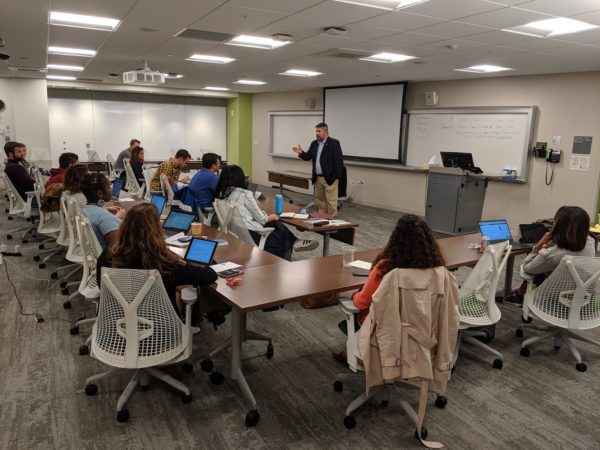15 Student Take-Aways: Startup Liabilities & Diversity at the 2nd Largest Custodial Bank on the Planet

As one might guess, students found his real-life examples related to tort liability (after classes on business formation, IP, and contracting) to be fascinating.
With light edits, below are key student take-aways.
Some noted Jason’s tips about contracting, especially as it relates to tort liability and due diligence in the context of supply chains:
“For startups, the fine-print in a contract is the best defense to avoid ADR and litigation, most disputes can/should be remedied before these are necessary. Security and by extension litigation risk is most vulnerable when using 3rd party vendors, the startup must vet them and then consider putting measures in place to isolate them from core activities as part of their preemptive defense against negligence. Situationally, indemnification clauses are important for the startup, transferring risk to vendors for agreed upon value, monetary or otherwise.”
“I really enjoyed last night’s class discussion and presentation. One thing that particularly stood out was when Jason was talking about the need to explore ‘deep within the supply chain’ in order to protect yourself and your company. I hadn’t realized just how important (or detrimental) these 3rd party organizations could be (the foreign factory in which employees don’t use masks or gloves when cutting fiberglass was memorable). This was essentially what happened with the Target scandal: Jason talked about how the data breach was accomplished through the company that handled the ventilation. I also appreciated the fact that Jason went over the importance to having to be as detailed as possible when writing contracts.”
About minimizing the risk of tort liability, and how it relates to a culture of CSR:
“My biggest takeaway for this class was fairly broad, but vitally important. When running or starting a business, you must take time to think of all scenarios that your product or service can be used and create language that will limit exposure.”
“My takeaway from this class relates back to corporate social responsibility, and how while companies focus on the profit margin, there is a risk that shortcuts in design and cutting the costs of the product can ultimately lead to liability issues. For example, Siedel’s text mentions the General Motors example: it was only $7-8 more expensive per unit to move or alter the gas tank in the car and instead the decision was made to keep it in an area where more lives and injuries could be at stake. This led to deaths and liability costs and damage to reputation that could have been avoided. In Jason’s case, the foreign component manufacturer he visited did not display any red flags in terms of lack of social responsibility with regard to employees or environmental safety.”
“My take-away from the class discussion was the importance of ethical business practices, corporate responsibility, and indemnification. Jason highlighted the idea of indemnification or ‘a hold harmless clause.’ Contracts with 3rd party vendors and suppliers need to be specific and clear to hold the other party accountable. In the case of the robotics company, who is liable? Indemnity clauses help to manage risk associated with a contract.”
Specifically, regarding negligence:
“My main take away relates to the thorough research that one must perform when considering dealing with other vendors. Jason provided a great example of his research and involvement with a vendor while in search of a component for their product. I can see how someone can easily become involved in litigation over malfunctioning components or hazardous materials used in their product, while simply trying to cut cost. Steps should be taken to prevent accusations of negligence later. Third party vendors must be researched and vetted accordingly when considering doing business with them.”
“Remember, depending on the circumstances, respondeat superior and joint and several liability can mean that someone-or-something – in addition to the person actually negligent – may be liable.”
Include disclaimers, warnings, and set consequences of various contingencies when contracting:
“I found Jason real world experiences with startups insightful and applicable to my own school and professional endeavors. Specifically, he mentioned startups should address product liability and protections in the contracts in early the early stages. Disclaimers and warnings are vital for new products, especially high-tech products like robotics. He also mentioned startups are in the growing stages and might not deliver everything on time as promised in a contract. You should include a clause specifying consequences to cover such contingencies.”
Regarding diversity initiatives, including at State Street, where Jason works:
“I was surprised to learn that the Dodd-Frank Act includes a provision to advance Diversity and Inclusion in the American banking system. Jason’s experience seeking out diversity in vendors was really interesting and surprising. The lack of legal standards that companies are held to when marketing themselves as ‘diverse’ or ‘sustainable’ was also surprising, and reminded me of the legality around labelling products as ‘natural’ with no substantive legal meaning behind it.”
One comment neatly tied Jason’s points on diversity initiatives and liability risk to one of our required readings by George Siedel:
“It was interesting to hear Jason talk about diversity initiatives and responsible sourcing. Tying it back to law and how irresponsible sourcing can cause legal ramifications down the line that didn’t seem possible at first was a good takeaway, touching on the three pillars: (1) Strategy: irresponsible sourcing will cause you customer-facing problems, (2) Ethics: it’s just morally irresponsible not to follow-up on where your supply is sourced and that it’s done ethically, and (3) Law: it has a big potential to expose you to unforeseen liabilities.”
